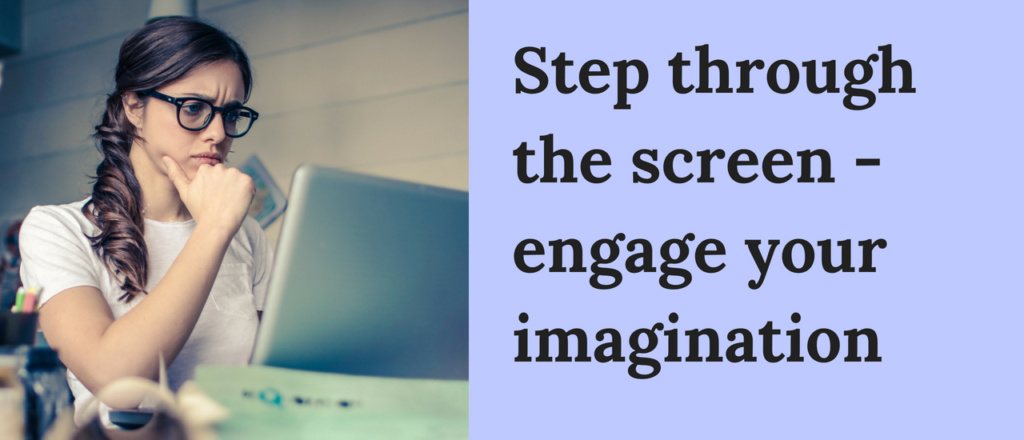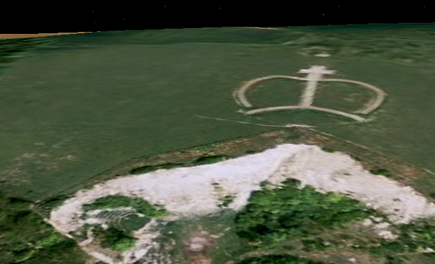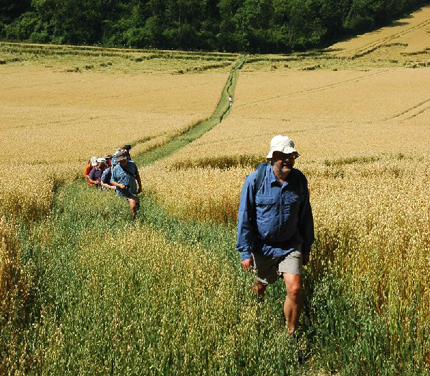Much of the advice available on researching novels is now dated. So this blog post includes the best modern tips on how to research fiction, with a case study included.
There I’ll show you step-by-step how I used the tools described below to construct a chapter in one of my novels. Once you’ve read through the tips and the Case Study you can even jump here to preview an ebook version of the completed product, which will give you a chance to assess how effective these tips are.
But first, for those who like to skim, let’s sum up the 7 basic pieces of advice on novel research.
How to research a novel
- Use Pinterest as you research your novel by building a visual reference guide
- Use tools like Google Street View to add a dash of realism to descriptions
- Wikipedia is good for researching cultures, places and times for historical novels
- Use Instagram hashtags to research specific locations in your novel
- You can use your dreams as a research tool!
- Remember to step through the screen as you research
- Post questions on Quora and Reddit to tap the real experience of strangers
1. Use Pinterest when researching your novel
Pinterest isn’t just great for collecting ideas for your next bathroom renovation or helping you find a really great bridesmaids dress – it’s also an invaluable tool for fiction writers looking to build a mental picture of what they’ll write about.
The key to Pinterest is that it’s a visual medium. So what you’re doing when using Pinterest to research a novel is collating images that will enrich your mental picture of the world you’re writing. The visual side of what you write is really important, and collecting images into Pinterest boards will give your imagination a real boost.
Tip: the best advice here is to go all-in on Pinterest. If you use it half-heartedly you run the risk of being excessively influenced by one or two images. But if you invest the time in collecting lots of diverse images that inform each part of your upcoming novel, then it’s more likely that the visuals that you write into the book will be greater than the sum of the parts that inspired them. So go for it: create some boards and start pinning picture that you find.
How to build a visual reference guide with Pinterest
There are two way you can approach Pinterest for novel research. The simplest is just to create a Pinterest account for yourself (or use your current one) then have it on hand as you browse the net so that you can pin images that inspire you as you stumble across them. The other more proactive way is to spend time researching in order to build a visual reference guide for each part of your book. To do this create boards for each aspect of your book that you feel needs more visual input – then search (both inside Pinterest and out) to build a visual library of images that speak to you. You can then refer back to these when writing to help spark your creativity.
Use Pinterest to create a mood board for each chapter
You can also collate images in Pinterest when researching your novel simply to help put your finger on a particular mood. A mood board for Bram Stoker’s Dracula, for instance, might include a board entirely filled with images of crumbling castles. But it could also include a mood board filled with photos of Romanian peasant village life to inform other scenes, and boards with images of upper-class Victorian life for the scenes that take place in London.
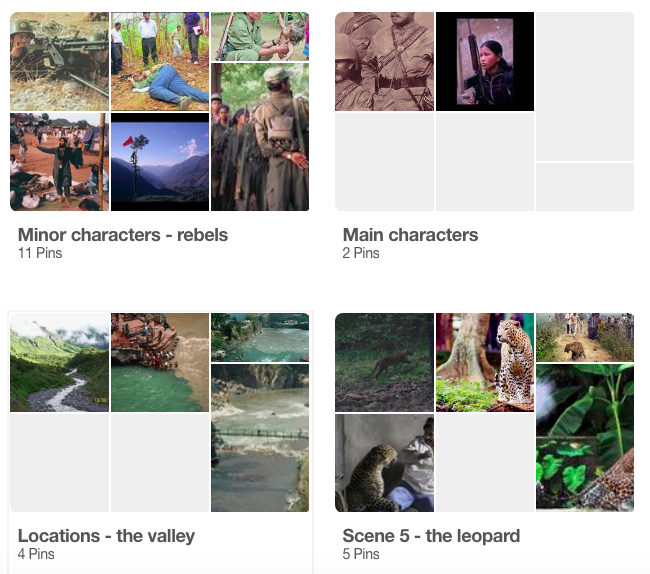
Use Pinterest to create a visual guide for each character
Drawing a blank when you try to picture an important character? Don’t stress. Just jump on Google Images and search all of the phrases that you have for your character. Are they tall, dark and brooding – Google that! Now look through any images that gel with what you had in mind and add them to the relevant board. Then rinse and repeat. By the end you’ll have a great sense of how your character looks.
2. Use Google products to research your novel
As the Google suite of products has expanded, so too have the tools available to authors. Don’t overlook the research techniques that Google now puts at your disposal.
Measure distance and travel times
When Character A needs to get to Location B it can help – if you’re writing in the real world, rather than a fantasy location – to ask Google for directions, in order to get a realistic sense of travel times. Writing about a road trip that you haven’t actually taken yourself? Avoid alienating readers that know the place by getting your distances and details right. And when it gets really crucial you can even use a point-to-point measuring tool in Google Maps by right clicking with you mouse on the map. That sniper shot across New York’s Central Park in your latest thriller is going to be that much more realistic when you know the space is exactly 845 metres wide.
Use Google Street View for flashes of veracity
Another great tip is dropping the little yellow figure on to the map to see exactly what any given street looks like from street level. You can really lift a scene – especially one set in a real place that you’ve never been to – by having your character note landmarks that are actually there. Maybe have them reflect on a church, or a distinctive building – or even notice some street art on a mural. Google Street View will help you add this layer of authenticity.
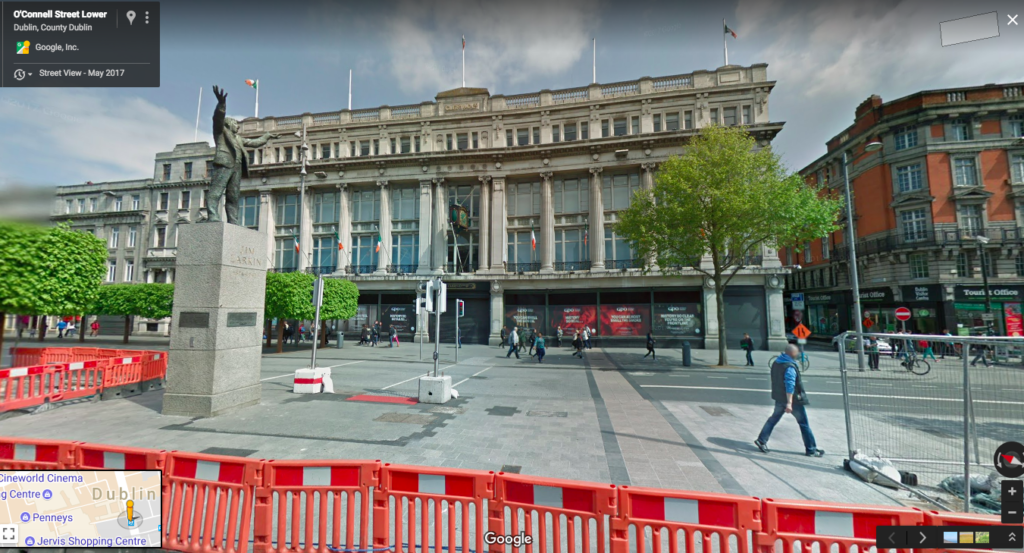
Find real shops and restaurants for particular scenes
In a similar vein to the point above, you can also easily set key scenes in real places with a little internet research. This can be a neat way to add veracity to a book, but it’s also a good way to step beyond your own visual limitations. What I mean is that you probably have a fairly straightforward scene in your head if you were to picture a generic cafe or restaurant – so by finding a real place online, you can really freshen a scene with a dose of reality. Top tip: menus are generally available via Google too!
Install Google Keep on your phone for taking notes on the go
Researching books isn’t just about collecting facts, it’s about having enough impressions and ideas to bring your scenes and characters – and their thoughts – to life for a reader. So if you see something unusual or striking in your day-to-day, jot it down and have your character notice it themselves in some scene, for that extra dash of realism. A notebook and pen in your back pocket is ideal for this – but better still is installing Google Keep on your phone so you can take your notes down there. You can organise them into handy sections, they’ll be automatically backed up to the cloud, and you can even record voice notes for when you’re on the move.
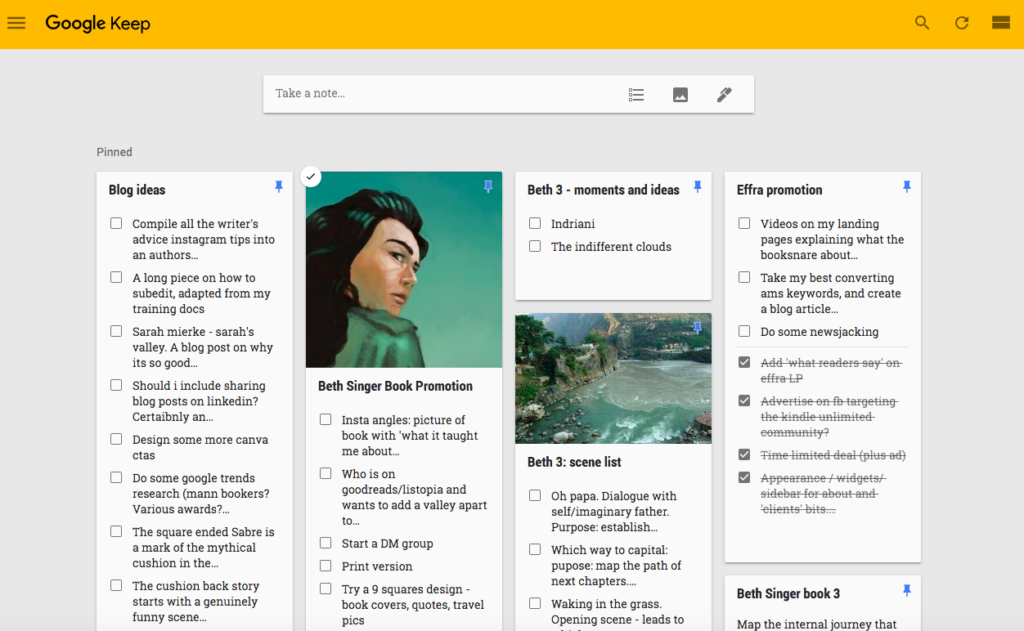
Use baby name databases for character names
There are a lot of internet baby name databases designed to help parents choose a moniker for bubs – and most include the meaning and origin of each name, which is very helpful if you want your character names to resonate with your themes. Have a strong female Middle Eastern character? Find an Arabic woman’s name that means ‘brave’. Or you can easily do a little Googling to find out, for example, what working class men’s names were popular in Victorian England. After all you cockney jewel thief main character won’t ring true when he is called Tarquin or Eustace if real cockneys of the time were called Frankie or Bill.
3. Use Wikipedia to research places and cultures for historical novels
Wikipedia is an invaluable tool for historical novelists. Its accounts of various historic periods, places, people, cultures and religions are a veritable rabbit hole that you can fall down, with convenient hyper-links to each related topic. Just be sure to copy out the parts that are most useful, so you don’t lose them as you venture deeper in…
4. Use Instagram to research places for your novel
Instagram is naturally a useful resource when building a mood board for any given character or scene (see the tips on using Pinterest above) but perhaps its greatest use for novelists planning a book is in helping authors visualise places that they’ve never been. Travel photographers here are a goldmine. Simply search for a certain location or place by hashtag, and follow anyone who regularly posts from that place for a steady stream of genuine visuals. For instance when researching for my young adult series set near Afghanistan and Iran I found a series of fantastic young Iranian photographers who regular posted pics that totally expanded my awareness of what those places really look like.
5. Use your dreams as a research tool
Okay here I’m not talking about your deepest wishes and desires – I’m talking about your actual nighttime dreams. These are a tremendous resource of material for any work of fiction and, unlike all of the internet research resources listed above, your dreams are utterly unique to you. If you’re lucky enough to have good dream recall, then get in the habit of jotting down in a notepad beside your bed what you can remember when you wake. If you do that before they fade you’ll find them invaluable material for any creative work – especially novels.
6. Remember to step through the screen
Okay, hopefully you’re finding these tips useful, but before we go on let’s remember one important thing. The internet has no smell and it doesn’t have a sense of touch. So there’s a real risk when you research a novel that the material you uncover is one-dimensional. Remember, your job as a writer is to make people feel an experience, not simply visualise or think about it. So be sure to step through the computer screen when you research and try to imagine what the things you are finding out about actually feel like in real life.
7. Use Quora and Reddit to research your novel
Quora and Reddit are online communities where you’ll get great traction by posting questions – so they’re another great tool for fiction research, especially on hard facts like ‘How far can a soldier march in one night?’ or ‘What’s the maximum operating altitude for a hot air ballon?’. And because those communities are full of random experts in all sorts of curious corners of knowledge, you can tap them for specialist details that you simply can’t source elsewhere: ‘What rights did women have in 17th Century Spain?’ perhaps (for those historical novelists again), or ‘What was considered elderly in Viking culture?’.
Top tip: identify these questions early on and post them at the start of your research journey to give people time to respond.
Use Quora and Reddit for the feels
Most importantly though, unlike any of the other research tools above, you can use these platforms to find out what an experience is actually like. Be sure to ask things like ‘What does it feel like being in your first firefight?’ or ‘What’s it like being swept up by an avalanche?’. This is the kind of level of realism that can make your novel shine.
Some Dos and Don’ts when researching a novel
To wrap up this part of what has hopefully been a useful post – and before we get in to a Case Study that gives an actual example of how this sort of research can play out, let’s look at some final dos and don’ts of the novel research game:
- Do use internet research to spark your imagination.
- Don’t use internet research to just assemble a collection of other people’s ideas.
- Do let research morph into actual writing. You need to take your inspiration where it comes.
- Don’t forget to back up your research (and manuscript). A simple upload to a free cloud service like Google Drive will save you heartache when your laptop harddrive fries or you leave it on the train.
- Do store your research in one place. Even a simple word doc with links at the start to all relevant social media accounts (e.g. Pinterest, Quora) followed by notes broken into sections will do.
- Do use your local library – but as a last resort. A physical trip there is likely a waste of your time, however pleasant. Find out what books you want to borrow by searching online, then order them through your library’s website.
Case study: Researching a novel in the age of Google
One of the things that only strikes you about writing a book after you’ve sat down and started is how crucial it is to write from immediate experience. It can be a real struggle to describe something you haven’t seen, smelled, heard and observed personally – and to stop it being a hollow and phoney reduction of other books and movies you’ve digested. Anyone who reads it is likely to sniff out that it’s phoney right away, and biff the book.
With this in mind, I thought I’d describe the process of writing a fiction chapter entirely via Google products – Google Maps, Streetview, Earth and Images – plus some extra research on Wikipedia.
It’s something that should have sounded a death knell for the chapter in question – but in this case, I think it worked. In fact, it’s probably my favourite out of the whole 87,000 word novel. (For those interested in seeing how using this approach played out, the chapter in question can be found in Effra, A Novel here)
It was a funny passage though. I decided to write it at a point where almost everything in the book had been planned. I had the logic of the plot and the themes and the development of the main characters all planned out in a kind of delicate arrangement (it only lacked a finale – that would come later). In my head it looked like a model of DNA – different threads wrapping around each other, all building towards a greater purpose. And I was pretty pleased with that image, because for a LONG time it had looked like a ball of wool that a cat’s played with. But then something funny happened. I’d sorted the logic of what happened and why and to whom – and the excitement died.
It felt like any reader who was familiar with basic story-telling would feel they were being hurried to a foregone conclusion. I was being careful to write a tight story, one without a lot of fat in it, but as a consequence you could see the bones. You could sense the logic. The story felt inevitable – and because it felt inevitable, it was no longer exciting. I’m a big believer in the reader providing at least half the story – after all, you make the pictures in your head, you provide the emotion – but a reader who feels like a story is inevitable, gets bored. Why should you care about a story that doesn’t let you play along, that seems intent on having things march along the way it wants, and expects you to just tag along for the ride?
So I decided to write something that would let the story breathe. Something completely pointless, that the reader would enjoy reading and I would enjoy writing (I think those two flow into each other): I sent my main characters on holiday.
Just for a short one – a train trip to the countryside for a day. The sort of thing I had done dozens of times from London. And anyway, I needed my characters to get close, and holidays are one way that happens. Perhaps by the time I finished the chapter, sparks would appear…
But where to go? This is where technology came in. I was writing about a trip out of London from a desk in suburban Auckland, and I wasn’t about to hop on a plane for research reasons, the way ‘real’ writers should. I had to do it over the net.
I needed them to visit a town a few hours, max, from London. It had to be on a train line – the characters had no car. It had to be small. And it had to be pretty.
I loaded Google Maps.
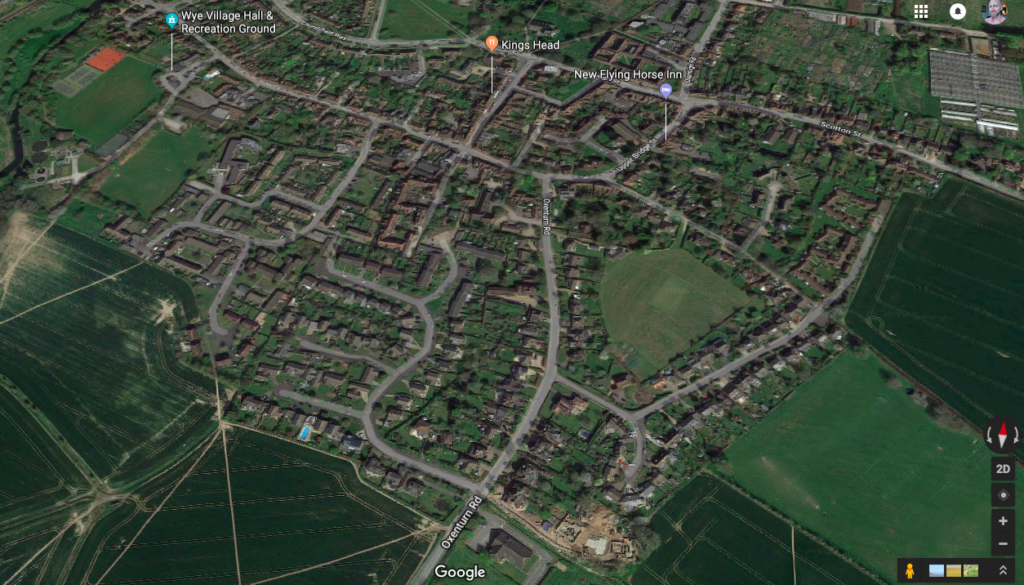
From London I scrolled around in a circle, and found the main train lines. Traced along the lines until I found towns – hunting for a small one somewhere nice. Sussex? Surrey? Kent… Kent would be good. Down the line I went, ’til I found Wye.
Well Wye not? Did it look nice? Up came Google Earth, I found the place and zoomed in – trees, fields, a line of hills – it was perfect. But what the hell was that?
The town had looked the right size, so using the tilt tool I’d raised the horizon up to a person’s perspective. That way I could see the place in the same way my characters would. I moved Google Earth to the train station where they’d disembark – and form their first impressions – and hit the 3D button for extra realism.
Up came the hills (or downs, rather), only to reveal a strange symbol carved in chalk – which would be visible from where they’d be standing.
This was perfect. My book had a theme of old things coming up through the surface of the modern – so this seemed like a gift from the gods. I would research what this strange symbol was via Wikipedia, and have my characters check it out as part of their day trip. Done.
Incidentally, anyone who’s read the book or this chapter will probably realise that the process of researching it matches closely to how the narrative evolves. The two characters start off not knowing where to go – they roll out a (real) map – choose the place, then pile out of the station and spot the carved chalk symbol. Everything they do just rolled out of the process of researching the town of Wye over a few days, and I wrote it as I went.
From the station I had them walk up the hill to the carved symbol, then I realised they would soon need some lunch. Out came Google Earth again – I needed to find them a pub. On Google Earth I spotted the next small town over (Crundale I think), and using the distance measure tool, I worked out that it was realistically walkable. Then I switched to Google Maps to get closer. That looked like a pub… I switched to Google Streetview and confirmed it – went back to Google Search to find the pub’s name, and had them walk over there across the downs. Phew.
Hey but what did those downs look like from ground level? At that point I started searching Google images for “Crundale” and “Wye” and found this idyllic shot of people walking between the two towns.
Perfect. What a relaxing image. It had exactly the feel I’d wanted to create in this chapter in the first place – that drifting holiday looseness. So where was the image from? Oh – the website of walking club for older gay men. Ha! And now that I looked closer at the people making their way down the hill, I realised I had a minor character in the making…
The portly gent in the floppy hat seemed just right. Plus, in all this research, I’d stumbled across the fact that Wye and Crundale are hotspots for rare English meadow butterflies. I imagined the gay walker in the photo as an amateur lepidopterist, and the character at the pub, David, was born.
I could go on and on about this chapter – actually I already have – so I’ll cut it short and just say that the whole experience generated a lot of writers luck. The butterfly thing matched with a mention I’d made in the book already; one of the streets in Wye had the same spooky name as a local Brixton lane; I’ve already mentioned the chalk carving: the whole thing just flowed and I wrote at top speed for two days. By the time I got my characters back home to London they, and I, were exhausted and the chapter’s ending – the sparks I’d hoped might be there – they just fell in to place naturally.
So to sum it up – and I’d like to hear what you think on this too – I reckon writing from internet research is dangerous.
For one thing, the internet doesn’t smell (except maybe if you pick that crud out of your mousewheel; I’m not sniffing that – and you shouldn’t either). It doesn’t have breezes or seasons, or move between dawn and dusk – there’s just one constant, backlit ever-day. In short, it’s not tactile in the ways I think you should draw on when writing. And on top of that, the experiences you do have are through someone else. You experience via someone else’s words, camera, website, Google-van, satellite, whatever – seeing things in a way they’ve been seen before – and I think you risk that derivative quality creeping into your writing.
Yet I like how my chapter came out.
And hell, the internet is incredibly powerful – you can get a street view of almost any place in the world, for crying out loud, without spending your life savings flying round the world researching like a ‘real’ writer. So I think that as a literary research tool, it’s here to stay.
But I think it’s crucial that when you use these tools you blend the things you gather with real experiences you’ve had –things that you’ve smelled, seen and thought – or you risk it coming out flat and flavourless.








